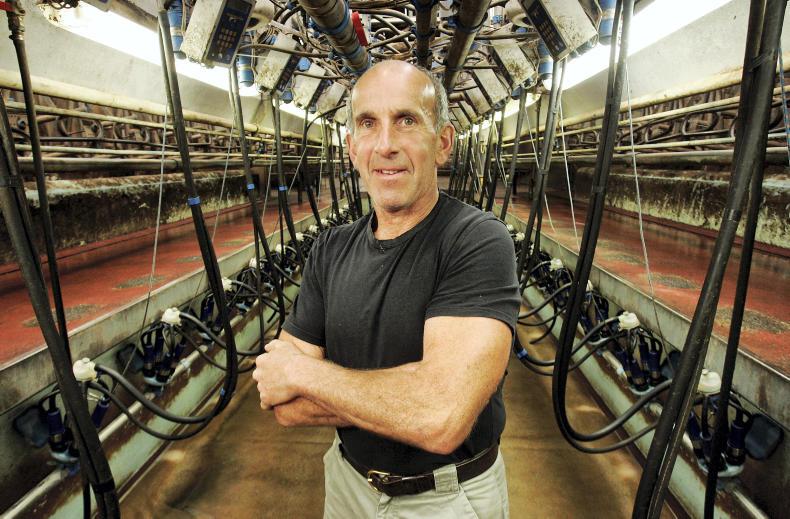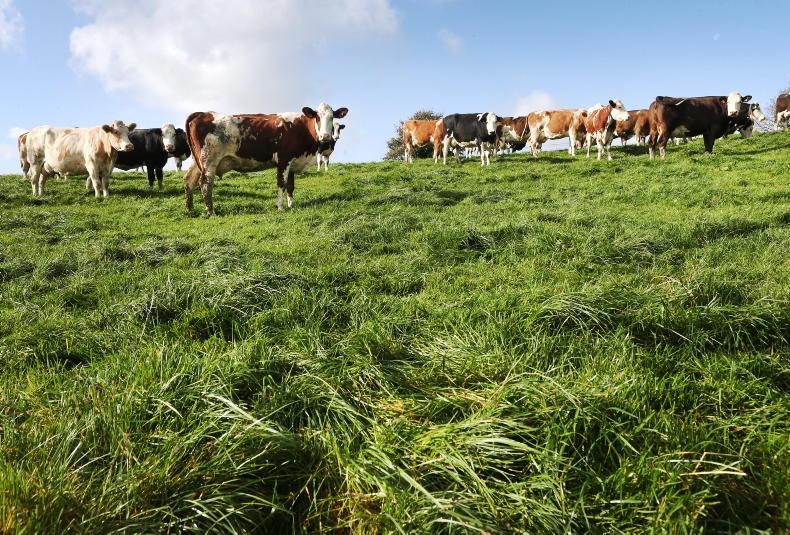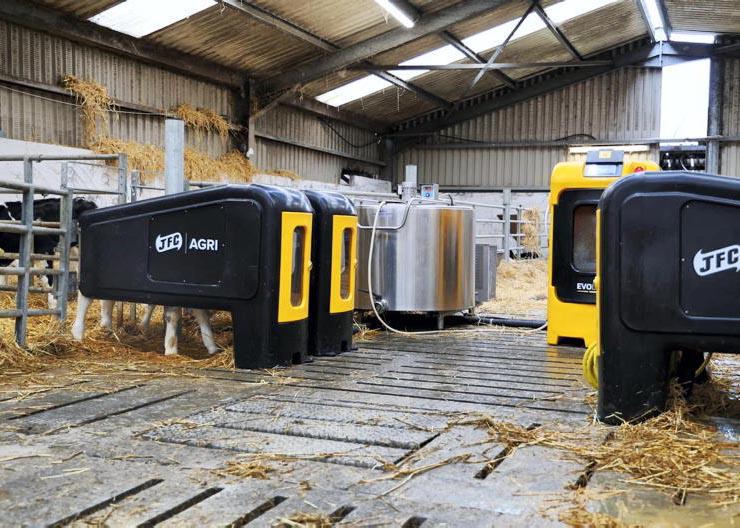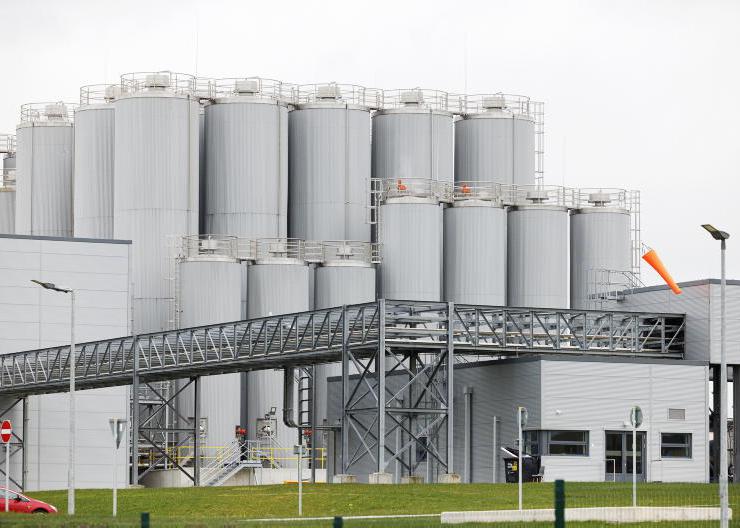Changes in feed efficiency at Heenandale farm have allowed Stephen and Hazel Wallace to make savings in feed costs while delivering an increase in milk output.
A review of benchmarking figures for the 2019 calendar year by Dairylink adviser Aidan Cushnahan shows milk yield per cow is up by 1.4% and meal fed per cow is down by 12%. Milk from forage has increased by almost 1,000 litres to 2,429 litres per cow.
Stephen has upped his game on the grass front since joining the programme in late 2018.
He is measuring and budgeting grass during the grazing season and this delivered a big improvement in the quality of grass going into cows last year.
A big focus is being placed on improving herd fertility on the Wallace farm, with the system moving towards a more compact autumn-calving profile. Better herd fertility improves feed efficiency as there will be more freshly calved cows, and fewer stale cows, in the milking herd.
Stephen and Hazel have been using DAERA’s Margin Over Concentrate (MOC) programme to track feed efficiency on a monthly basis.
MOC is effectively how much of the milk cheque is left over after the meal bill has been paid each month.
As Table 1 shows, MOC fell year-on-year, despite the outlined improvements in feed efficiency.
This is due to a 1.6p/l reduction in average milk price last year (27.1p/l).
This is outside of a farmer’s control and Aidan Cushnahan points out that if feed rates in 2019 had remained at 0.36 kg/l, the resultant MOC would have been £1,351/cow and not £1,446/cow.
Table 1 also shows that herd size and overall milk output increased during the year while the land area stayed the same. Soil fertility improvements, reseeding and better grassland management have allowed the farm to grow more grass and increase overall stocking rate from 2.19 LU/ha to 2.49LU/ha.
Finances
The main farm working expenses for Heenandale farm in 2019 are outlined in Figure 1. Dairy feed accounts for the highest proportion of costs at £118,863. More efficient feeding has delivered for the bottom line as an extra £19,152 would have been spent on concentrates last year if feed rates remained the same as 2018.
Machinery running costs and contractor costs were the next highest contributors at £30,323 and £25,254 respectively. A range of expenses is contained in “other costs” and includes labour, electricity, professional fees, straw and repairs. Overall, total farm working expenses were £338,610 (23.1p/l) last year.
Total receipts, excluding Basic Payment, stood at £452,319 in 2019. A standardised figure for personal drawings of £30,000 is used for financial benchmarking on all Dairylink Ireland farms. When this is included, we see that the money available for loan repayments, capital expenditure and tax stood at £83,795 last year.
Monthly MOC figures suggest there is scope to further improve feed efficiency on Heenandale farm, particularly by making more use of grazed grass. As Table 2 shows, milk from forage was 14.1l/cow/day in May 2019 and the corresponding MOC was £5.33/cow/day. However, if 20 l/cow/day had been coming from forage, MOC would have been £6.00/cow/day and total margins for the month would have been increased by £3,655.
It shows every extra litre from grazed grass or silage and every kilo of concentrate saved can have an impact on the bottom line.
Stephen and Hazel are also keen to get more production from grass by turning stock out earlier. Indeed, some youngstock were turned out last week and 80 cows are now at grass by day. Around 20 acres of the farm were reseeded in 2019 and the plan is to include this into the grazing rotation which should increase the amount of quality grass available for milking cows.
A private firm is being used on Heenandale farm to assist with improving herd fertility. This involves a contractor visiting the farm daily to check heats and AI cows.
Sires are also being selected to improve the production of milk solids within the herd. In the longer term, this will deliver financially through better bonus payments for milk quality.
Weekly round-up
Ground conditions have improved on Dairylink Ireland farms over the past week.Youngstock and some milking cows are being turned out to grass.Some programme farmers are also catching up spreading slurry and first round fertiliser.Dairylink participants are being encouraged to walk grazing blocks to assess ground conditions and measure grass covers.Aidan Cushnahan
A few small changes can make a big difference to the physical and financial performance of a farm business within a year. There are lessons from the Wallace farm which are applicable to any dairy farmer that wants to improve their bottom line by capitalising on homegrown feed. Now is the best time to think about how to grow and utilise more better quality grass during 2020.
Read more
Calf rearing in full swing in Co Down
Dairylink: reviewing and updating cashflow plans
Changes in feed efficiency at Heenandale farm have allowed Stephen and Hazel Wallace to make savings in feed costs while delivering an increase in milk output.
A review of benchmarking figures for the 2019 calendar year by Dairylink adviser Aidan Cushnahan shows milk yield per cow is up by 1.4% and meal fed per cow is down by 12%. Milk from forage has increased by almost 1,000 litres to 2,429 litres per cow.
Stephen has upped his game on the grass front since joining the programme in late 2018.
He is measuring and budgeting grass during the grazing season and this delivered a big improvement in the quality of grass going into cows last year.
A big focus is being placed on improving herd fertility on the Wallace farm, with the system moving towards a more compact autumn-calving profile. Better herd fertility improves feed efficiency as there will be more freshly calved cows, and fewer stale cows, in the milking herd.
Stephen and Hazel have been using DAERA’s Margin Over Concentrate (MOC) programme to track feed efficiency on a monthly basis.
MOC is effectively how much of the milk cheque is left over after the meal bill has been paid each month.
As Table 1 shows, MOC fell year-on-year, despite the outlined improvements in feed efficiency.
This is due to a 1.6p/l reduction in average milk price last year (27.1p/l).
This is outside of a farmer’s control and Aidan Cushnahan points out that if feed rates in 2019 had remained at 0.36 kg/l, the resultant MOC would have been £1,351/cow and not £1,446/cow.
Table 1 also shows that herd size and overall milk output increased during the year while the land area stayed the same. Soil fertility improvements, reseeding and better grassland management have allowed the farm to grow more grass and increase overall stocking rate from 2.19 LU/ha to 2.49LU/ha.
Finances
The main farm working expenses for Heenandale farm in 2019 are outlined in Figure 1. Dairy feed accounts for the highest proportion of costs at £118,863. More efficient feeding has delivered for the bottom line as an extra £19,152 would have been spent on concentrates last year if feed rates remained the same as 2018.
Machinery running costs and contractor costs were the next highest contributors at £30,323 and £25,254 respectively. A range of expenses is contained in “other costs” and includes labour, electricity, professional fees, straw and repairs. Overall, total farm working expenses were £338,610 (23.1p/l) last year.
Total receipts, excluding Basic Payment, stood at £452,319 in 2019. A standardised figure for personal drawings of £30,000 is used for financial benchmarking on all Dairylink Ireland farms. When this is included, we see that the money available for loan repayments, capital expenditure and tax stood at £83,795 last year.
Monthly MOC figures suggest there is scope to further improve feed efficiency on Heenandale farm, particularly by making more use of grazed grass. As Table 2 shows, milk from forage was 14.1l/cow/day in May 2019 and the corresponding MOC was £5.33/cow/day. However, if 20 l/cow/day had been coming from forage, MOC would have been £6.00/cow/day and total margins for the month would have been increased by £3,655.
It shows every extra litre from grazed grass or silage and every kilo of concentrate saved can have an impact on the bottom line.
Stephen and Hazel are also keen to get more production from grass by turning stock out earlier. Indeed, some youngstock were turned out last week and 80 cows are now at grass by day. Around 20 acres of the farm were reseeded in 2019 and the plan is to include this into the grazing rotation which should increase the amount of quality grass available for milking cows.
A private firm is being used on Heenandale farm to assist with improving herd fertility. This involves a contractor visiting the farm daily to check heats and AI cows.
Sires are also being selected to improve the production of milk solids within the herd. In the longer term, this will deliver financially through better bonus payments for milk quality.
Weekly round-up
Ground conditions have improved on Dairylink Ireland farms over the past week.Youngstock and some milking cows are being turned out to grass.Some programme farmers are also catching up spreading slurry and first round fertiliser.Dairylink participants are being encouraged to walk grazing blocks to assess ground conditions and measure grass covers.Aidan Cushnahan
A few small changes can make a big difference to the physical and financial performance of a farm business within a year. There are lessons from the Wallace farm which are applicable to any dairy farmer that wants to improve their bottom line by capitalising on homegrown feed. Now is the best time to think about how to grow and utilise more better quality grass during 2020.
Read more
Calf rearing in full swing in Co Down
Dairylink: reviewing and updating cashflow plans










SHARING OPTIONS